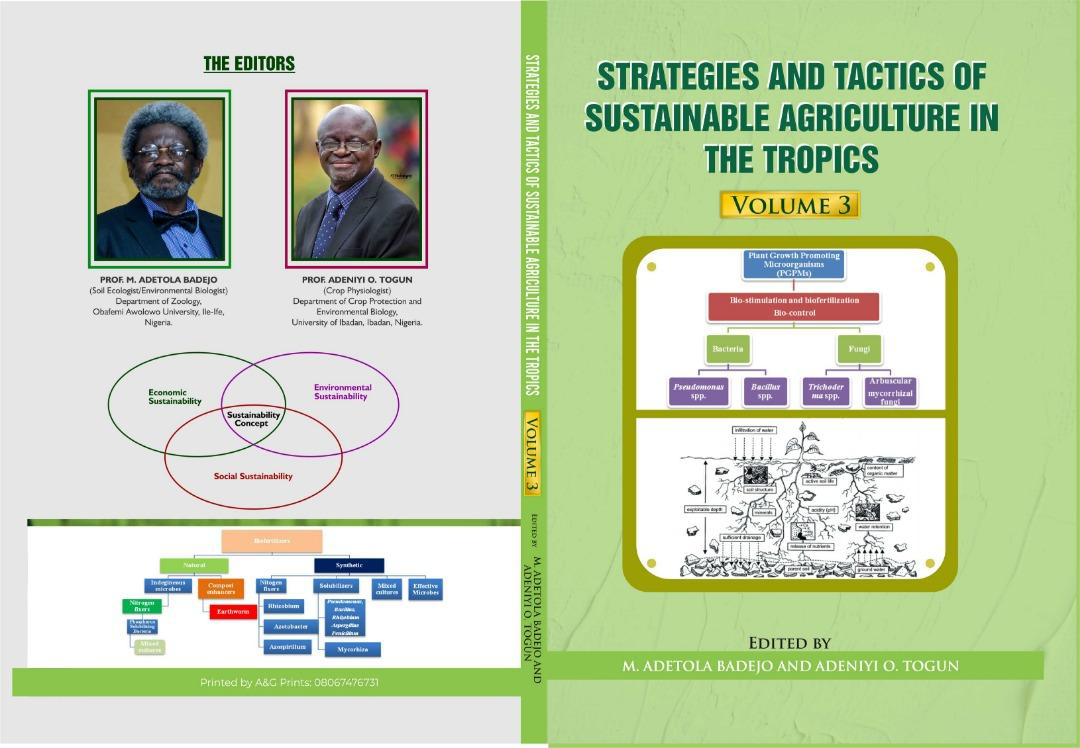
Little did we know when we published the first volume of STASAT in 1998 that it was a legacy project. There were fifteen chapters in this first volume which focused on the failure of Green Revolution to boost agricultural productivity in tropical countries and exposed the potentials of eco-friendly agricultural practices. In this first Volume, the concept of sustainability in agroecosystems was proved by a philosopher to be a reality and not amyth.
Six years later, 12 chapters were contributed by various researchers in the broad area of environmental protection in Agriculture. The justification for the publication of this second volume was that a large percentage of hungry and malnourished human populations consist of the rural and urban poor in tropical countries where land resources are extremely fragile and not easy to manage. A case was made for the constant revisitation of the strategies and tactics for attaining adequate food production evenly throughout the globe. Empirical data provided in every chapter of this second volume vary from how the fragile soils of the tropical region can be conserved and rehabilitated, through the paucity of fauna that play vital roles in maintenance of soil fertility, to the deplorable conditions, to the importance of proper management of soil fauna for improved fertility. to sustainable land-management option, management of organic matter in agroecosystems, proper understanding of appropriate cropping systems and selection of varieties for various agroecological zones. The element of post-harvest loss which the farmer has to manage properly so as not to loose the inadequate food produced to pests during storage were also addressed. An overview of major insect pests and the damage they do to stored crops and their by-products was presented and various alternatives to synthetic insecticides that are more capable of achieving sustainability than synthetic insecticides were discussed. Management problems that militate against achievement of sustainability and the options that hold the key to the future were also discussed. Pertinent management issues were raised by experienced researchers from South America while two Nigerian researchers rounded the volume up with suggestions on management of incessant fire in dry regions and how institutional and policy formulations and reforms could be developed to achieve sustainability in the waterlogged Fadama in a dry region in Nigeria.
This second volume which we thought was the final volume was perceived by us as the end of the beginning of our desire to draw global attention to the hydra-headed problem of achievement of sustainability in tropical agro-ecosystems. As the saying goes, whatever has a beginning must have an end. For STATAT to have an end, all productivity problems in the tropical belt must have been solved. In as much as the first two volumes of STATAT tried to shape the future of agricultural research in tropical countries, the solutions remain elusive due to unguided reliance on solutions in the temperate environments where land configuration, fertility status, characteristic fauna and cultural situations all differ in great magnitudes and diverse dimensions. A third volume therefore becomes inevitable and it took us fifteen years to accomplish this. This long delay arose from our involvement in administrative duties in our universities. Now that we are relieved of such duties, we have found time to seek the contributions of our colleagues in this legacy project which we believe will endure long after our imminent retirement.
This third volume focuses on agricultural productivity in the sub-sahara. Six of the chapters are papers presented at the National conference of the School of Agriculture and Agricultural Technology (SAAT) in the Federal University of Technology Akure (FUTA) in 2019.
The 21st century commenced two decades ago and humankind is still being confronted with a wide array of challenges in the area of food production and distribution. The latest United Nations projections indicate that the world population will reach 10 billion in the year 2056. This implies a 33.3% increase in the next 36 years. It is therefore imperative that alleviation of hunger and poverty is on the front burner on a global scale. While this is being done, efforts must be made to maintain the life-support systems provided by all natural environments on earth. This brings to mind the philosopher’s plea in the first volume of this book (Chapter 1) that“….. nature might be inclement to us and obstructive of our desire for survival. Wemust therefore … tenderly lobby nature, coax it, placate it and exploit it without corrupting it, all in ways that will have to be clearly worked out and diligently followed by all”. By so doing, man will be in a vantage position to achieve Altieri’s projections on Natural Resources Management (see Chapter 9 of Volume 2) whose end results include poverty alleviation, food security and self reliance, ecological management of productive resources and empowerment of rural communities.


